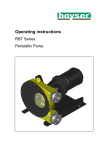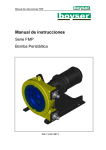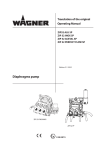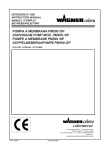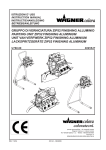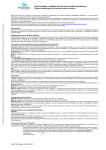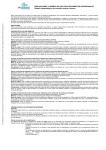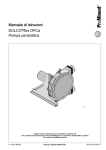Download Operating instructions
Transcript
Operating instructions AMP Series Peristaltic Pump AMP Instruction Manual Tableofcontents 1. Introduction ...................................................................................... 3 2. Safety and Responsibility .................................................................. 5 3. Functional description ....................................................................... 9 4. Transport and Storage .................................................................... 11 5. Assembly and Installation ............................................................... 12 6. Commissioning................................................................................ 18 7. Maintenance, repair, malfunctions, disposal and spare parts ......... 19 8. Spare parts ..................................................................................... 22 9. Declaration of Conformity ............................................................... 31 10. Guarantee ...................................................................................... 32 2 AMP Instruction Manual 1. Introduction This manual forms an integral part of the pump and must accompany it until its demolition. The series AMP peristaltic pump is a machine destined to work in industrial areas and as such the instruction manual must form part of the legislative dispositions and the applicable technical standards and does not substitute any installation standard or eventual additional standard. 1.1 Explanation of the safety information The instructions of this manual, whose inobservance is determined as a failure to meet safety standards, are identified by this symbol The instructions of this manual, whose inobservance compromises electrical safety The instructions of this manual, whose inobservance compromises the correct working of the pump, are identified with this symbol. 1.2 Users’ qualifications Pumps are machines that due to their functioning under pressure and moving parts can present dangers. - Improper use - Removing the protections and/or disconnecting the protection device 3 AMP Instruction Manual - The lack of inspections and maintenance They can cause serious damage or injury. The person in charge of safety should therefore guarantee that the pump is transported, installed, put in service, used, maintained and repaired by qualified personnel who should therefore possess: - Specific training and sufficient experience. - Knowledge of the technical standards and applicable laws. - Knowledge of the general national and local safety standards and also of installation. Any work carried out on the electrical part of the pump should be authorized by the person responsible for safety. Given that the pump is destined to form part of an installation, it is the responsibility of whoever supervises the installation to guarantee absolute safety, adopting the necessary measures of additional protection. 4 AMP Instruction Manual 2. Safety and Responsibility 2.1 General safety information Live parts Possible consequence: Fatal or very serious injuries. - Measure: The device must be disconnected from the power supply before it is opened Isolate damaged faulty or manipulated devices from the mains in order to de-energise. Emergency stop switch Possible consequence: Fatal or very serious injuries. An emergency stop switch is to be connected for the entire plant. This should enable the entire plant to be shut down in the event of an emergency in such a way that the overall plant can be brought into a safe condition. Unauthorized access Possible consequence: Fatal or very serious injuries. - Measure: Ensure that there can be no unauthorized access to the unit. Hazardous media/contamination of persons and equipment Possible consequence: Fatal or very serious injuries material damage. - - Ensure that the pump hoses are resistant against the media being conveyed Always observe the safety data sheets for the media to be conveyed. The system operator must ensure that these safety data sheets are available and that they are kept up-to-date. The safety data sheets for the media being conveyed are always decisive for initiating countermeasures in the event of leakage to the media being conveyed. 5 AMP Instruction Manual Observe the general restrictions in relation to viscosity limits, chemical resistance and density. Always switch the pump off before exchanging the pump hose - Correct and proper use Possible consequence: Fatal or very serious injuries. - - - - The unit is not intended to convey or regulate gases or solid media Do not exceed the rated pressure, speed or temperature for the pump The unit may only be used in accordance with the technical data and specifications provided in these operating instructions and in the operating instructions for the individual components The system is not designed for use in areas of risk from explosion Only switch the pump on if it has been properly fastened to the floor Only switch the pump on if it the front cover has been attached. Do not carry out any maintenance operations or dismantle the pump without first making sure that the pipes are not under pressure and are empty or isolated. In the case of the hose becoming stuck during extraction or fitting it is necessary to reverse the direction of the pump, relubricate, and then repeat the operation. As the peristaltic pump is volumetric and its functioning is positive displacement, it is necessary to prevent a possible overload of pressure, due to for example, the accidental closure of a valve. For this reason it is advisable to fit a safety device such as: a safety valve, pressure limiter, etc. Operational lifetime of the pump hoses Possible consequence: Fatal or very serious injuries. The operational lifetime of the pump hoses cannot be precisely specified. For this reason, the possibility of fracture and consequential leakage of liquids must be accounted for. If the hose rupture alarm (optional) is fitted, then the pump can be stopped and / or an electrical valve can be actuated. 6 AMP Instruction Manual In addition, as the hose has an indeterminate life and due to the possibility of its breakage or deterioration, the user is responsible for the prevention of a possible (although most unlikely) incorporation of particles form the hose into the product being pumped. This can be achieved e.g. by means of filtration, a hose rupture alarm or other means suitable for the respective process CIP cleaning In the event of CIP cleaning, it is necessary to obtain information from the manufacturer about correct installation of the pump (a special installation is required) as well as regarding the compatibility of the cleaning agents with the pump hoses and the hydraulic connections. Cleaning should be undertaken at the recommended maximum temperature. Direction of rotation/flow direction Possible consequence: Material damage right through to destruction of the unit. - The pump's direction of rotation in relation to the desired flow direction must be checked prior to every start. Disconnect the pump from the mains Possible consequence: Personal injury. You may only carry out work on the pump after it has previously been switched off and disconnected from the mains. 7 AMP Instruction Manual Environmental influences Possible consequence: Material damage right through to destruction of the unit. - The device is not suitable for outdoor operation Take suitable measures to protect the device from environmental influences such as: – UV rays – Moisture – Frost, etc. 8 AMP Instruction Manual 3. Functional description The AMP Series is a displacement pump. The feed chemical is conveyed by the rotor squeezing the hose in the direction of flow. No valves are needed for this. This ensures gentle handling of the metered media. The AMP Series has been designed for safe and uncomplicated operation, as well as straightforward maintenance. The AMP Series can be used for many different media. However, this pump type is often the optimal solution for abrasive, shear-sensitive and viscose media. Typical areas of use include processes where only a low discharge pressure is required (max. 8 bar). 3.1 Construction Main modules: - Drive Unit Housing Base frame The pump housing is closed off with a screwed front cover in order to avoid the risk of injury. The motor serves to drive the rotor. Two rollers at the ends of the rotor serve to press the pump hose against the pump housing. The rotary movement of the rotors alternately press and relax the rollers in relation to the pump hose. This serves to suck the media and convey it into the metering line. 9 AMP Instruction Manual Fig. 1: Diagram of functional principle 1 Housing 3 Rollers 2 Rotor 4 Hose 10 AMP Instruction Manual 4. Transport and Storage 4.1 Transport - The pump is protected by a cardboard packaging. - The packaging materials are recyclable. 4.2 Storage - The pump should be in a resting position. (The hose should not be compressed). - Avoid areas open to harsh weather or excessive humidity. - For storage periods of longer than 60 days, protect the coupling surfaces (clamps, reducers, motors) with adequate anti-oxidant products. - Spare hoses should be stored in a dry place away from direct light. 11 AMP Instruction Manual 5. Assembly and Installation 5.1 Ambient conditions Assembly is to be carried out in the following order. If the pump has to be installed outdoors, then it is to be equipped with protection against sunlight and weather influences. When positioning the pump, ensure that sufficient room for access is provided for all types of maintenance work. Limit values for hose temperature and pressure Material Hose Max. Pressure (Bar) Min. Temp. (ºC) Feed chemical Max. Temp (ºC) Feed chemical Min. Temp (ºC) Environment NR - 20 80* - 40 8 NBR - 10 80* - 40 8 EPDM - 10 80* - 40 8 NR-A - 10 80* - 40 8 NBR-A - 10 80* - 40 8 NORPREN - 10 120* - 40 2 TYGON - 10 70* - 40 2 * At max. Tª, the life of hose is drastically reduced. Please contact with Boyser or authorized distributor for high Tª application. 5.2 Correct installation of the pump 5.2.1 Suction side The pump is to be positioned as near as possible to the liquid container, so that the suction side is kept as short and straight as possible. The suction line must be absolutely airtight and made of a suitable material, so that it is not squeezed together under vacuum. The diameter must correspond to the rated diameter of the pump hose. A larger diameter is recommended in the event of viscose liquids. The pump is self-priming and does not require an admission valve. The pump is reversible and the suction connection can therefore comprise of one of 12 AMP Instruction Manual two options. Normally the option is selected which is best suited to the physical conditions of the installation. It is recommended to use a flexible transition between two fixed pipes and the hydraulic connection of the pump, in order to avoid the transmission of vibrations. 5.2.2 Discharge side The discharge line is to be kept as straight and short as possible, in order to avoid performance reduction. The diameter must correspond to the rated diameter of the pump hose. A larger diameter is recommended in the event of viscose liquids. It is recommended to use a flexible transition between two fixed pipes and the hydraulic connection of the pump, in order to avoid the transmission of vibrations. 5.3 Adjusting the roller pressure The peristaltic pump is equipped with shims, in order to adjust the precise pressure distance to the roller (dependent on speed and operating pressure). Fig 2: 1- Roller / 2- Shims 13 AMP Instruction Manual Fig. 3: Squeezing the hose 1. Hose in normal shape 2. Insufficient squeezing (back flowing media in the cavity will destroy the hose within a short period of time) 3. Perfect squeezing 4. Excessive squeezing (increased wear and tear to pump and hose) The shims are fitted in the factory. You can adapt the number of shims to the actual operating conditions according to the following table. 14 AMP Instruction Manual 5.3.1 AMP-10/B Model (Number of shims of 0,5 mm thickness ): a) NR, NBR, EPDM, HYPALON, NR-A and NBR-A: 1/min 0-19 20-39 40-59 60-79 0,5 1 1 1 1 2,0 1 1 1 1 Bar 4,0* 2 1 1 1 6,0 2 2 2 -8,0 3 2 --*Factoring default setting if working pressure is not informed 80-99 1 1 1 --- b) Norprene: 1/min 0-19 20-39 40-59 60-79 0,5 5 5 5 5 Bar 2,0* 5 5 5 5 *Factoring default setting if working pressure is not informed 80-99 5 5 5.3.2 AMP-13/B Model (Number of shims of 0,5 mm thickness ): a) NR, NBR, EPDM, HYPALON, NR-A and NBR-A: 1/min 0-19 20-39 40-59 60-79 0,5 1 1 1 1 2,0 1 1 1 1 Bar 4,0* 2 1 1 1 6,0 2 2 2 -8,0 3 2 --*Factoring default setting if working pressure is not informed 80-99 1 1 1 --- b) Norprene: 1/min 0-19 20-39 40-59 60-79 0,5 5 5 5 5 Bar 2,0 5 5 5 5 *Factoring default setting if working pressure is not informed 80-99 5 5 15 AMP Instruction Manual 5.3.3 AMP-16/C Model (Number of shims of 0,5 mm thickness ): a) NR, NBR, EPDM, HYPALON, NR-A and NBR-A: 1/min 0-19 20-39 40-59 60-79 0,5 1 1 1 1 2,0 1 1 1 1 Bar 4,0* 2 1 1 1 6,0 2 2 2 -8,0 3 3 --*Factoring default setting if working pressure is not informed 80-99 1 1 1 --- b) Norprene: 1/min 0-19 20-39 40-59 60-79 0,5 9 9 9 9 Bar 2,0* 9 9 9 9 *Factoring default setting if working pressure is not informed 80-99 9 9 5.3.4 AMP-19/C Model (Number of shims of 0,5 mm thickness ): a) Norprene and Tygon: 1/min 0-19 20-39 40-59 60-79 0,5 5 5 5 5 Bar 2,0* 5 5 5 5 *Factoring default setting if working pressure is not informed 80-99 5 5 5.3.5 AMP-22 Model (Number of shims of 0,5 mm thickness ): a) NR, NBR, EPDM, HYPALON, NR-A and NBR-A: Bar 0,5 2,0 4,0* 6,0 0-19 2 2 3 3 20-39 2 2 3 3 1/min 40-59 1 2 2 3 60-79 1 2 2 -- 80-99 1 2 2 -16 AMP Instruction Manual 1/min 0-19 20-39 40-59 60-79 Bar 8,0 4 3 --*Factoring default setting if working pressure is not informed 80-99 -- b) Norprene: 1/min 0-19 20-39 40-59 60-79 0,5 12 12 12 12 Bar 2,0* 12 12 12 12 *Factoring default setting if working pressure is not informed 80-99 12 12 17 AMP Instruction Manual 6. Commissioning 6.1 Testing prior to commissioning the pump The following tests are to be carried out: - Ensure that the pump has not been damaged during transportation or storage. Immediately report any damage to the supplier. - Check that the mains voltage is suitable for the motor. - Ensure that the hose is suitable for the fluid to be conveyed and that it is not damaged. - Make sure that the temperature of the liquid does not exceed the recommended temperature range. - Only switch the pump on if it the front cover has been properly attached. - Check that the rollers are correctly fitted and fastened. - Check that the drive pump and the inner of the rollers are correctly greased. The specially formulated grease can be obtained from BOMBAS BOYSER, S.L. or from the authorized distributor. - Check that the thermal overload protection (not included in the delivery scope) corresponds to the value specified on the motor type plate. - Check whether the direction of rotation is correctly adjusted. - Check that the optional electrical components are connected and are working properly. - Install a manometer in the pressure line if the back-pressure value is unknown. - Check the operating instructions in order to ensure that the flow values, pressures and power consumption of the motor do not exceed the rated values. - Install a pressure relief valve in the pressure line in order to protect the pump in the event that a valve is unintentionally closed off or the line is blocked in another way. 18 AMP Instruction Manual 7. Maintenance, repair, malfunctions, disposal and spare parts 7.1 Lubrication: - Check that the rollers and the hose are sufficiently lubricated o Check every 300 operating hours - Gear reducer o The lubrication is permanent. Is not necessary any servicing 7.2 Exchanging the pump hoses 7.2.1 Exchanging the pump hoses – dismantling 1. Close off all valves, in order to prevent leakage of the feed chemical 2. Dismantle the pump pipes from both discharge and suction sides 3. Remove the front cover 4. Remove a roller (the roller that is not touching the pump hose) 5. Mount the front cover 6. Turn the rotor with the help of the motor so that the remaining roller is not pressing against the pump hose 7. Dismount the front cover 8. Remove the press flange from the pump housing 9. Remove the pump hose to be exchanged 10. Dismantle the hydraulic connections from both pump hose ends 7.2.2 Exchanging the pump hoses- installation 1. Clean the interior surfaces of the pump housing 2. Lubricate the internal surfaces of the pump housing at the contact surfaces to the pump hose with original silicon grease 3. Check the rollers. Ensure that the roller surfaces are not damaged 4. Attach the hydraulic connections at both hose ends with the help of the press flange 19 AMP Instruction Manual 5. Lay the pump hose into the pump housing 6. Fasten the press flange to the pump casing 7. Mount the front cover 8. Turn the rotor with the help of the motor so that the remaining roller presses against the pump hose 9. Dismount the front cover 10. Re-attach the second roller with shims back onto the rotor 11. Lubricate the pump hose and the rollers 12. Attach the front cover to the pump housing 13. Mount the pipes from both discharge and suction sides 14. Open all of the valves 7.3 Troubleshooting Problem Increased pump temperature Reduced flow or pressure Possible cause Solution Pump hose has no lubricant Lubricate pump hose Increased product temperature Reduce product temperature Insufficient or poor suction conditions Check suction line for blockages Pump speed too high Reduce pump speed Valves on discharge and or suction side completely or partially closed Open valves Pump hose insufficiently compressed Check number of shims Pump hose rupture (the product leaks out into the housing) Exchange pump hose Partial blockage of the suction line Clean pipe Insufficient product quantity in storage container Fill storage container or exchange pump Insufficient diameter on the suction side Increase the diameter on the suctions side, as far as possible Suction line too long Shorten the suction line, as far as possible High viscosity of medium Reduce viscosity, as far as possible Air introduction in the suction connections Check connections and accessories for air tightness 20 AMP Instruction Manual Reduced flow or pressure Vibrations on pumps and pipelines Short operational lifetime of the hoses Pump hose pulled into the pump housing The pump does not start up High pulsation on suction Tighten connections and accessories Mount antipulsation equipment Reconsider application (speed, etc) The pipes are not correctly fastened Fasten pipes correctly (e.g. wall brackets) Pump speed too high Reduce pump speed Insufficient nominal width of the pipes Increase nominal width Pump base plate loose Fasten base plate Pulsation dampers insufficient or missing Install pulsation dampers on suction and / or discharge side. Chemical exposure Check the compatibility of the hose with the liquid being conveyed, the cleaning fluid and the lubricant High pump speed Reduce pump speed High conveying temperature Reduce product temperature High operating pressure Reduce operating pressure Pump cavitation Check the suction conditions Abnormal elevation of temperature Check rollers shaft mounting Unsuitable lubricant Use lubricant BOYSER Insufficient quantity of grease Top up lubricant High inlet pressure (> 3 bar) Reduce inlet pressure Pump hose filled with deposits Clean or replace the pump hose Holder (press flange) insufficiently tightened Re-tighten holder (press flange) Insufficient grease Top lubricant Insufficient motor performance Check motor and replace if necessary Insufficient output from frequency converter The frequency converter must match the motor Check voltage. Start occurs at minimum 10 Hz Check if the suction or discharge side is blocked. Rectify blockage Blockage in the pump Blockage in the pump 21 AMP Instruction Manual 8. Spare parts 8.1 Spare parts exploded AMP-10/B and AMP-13/B Model 22 AMP Instruction Manual 8.1.1 AMP-10/B Model Pos. 1 2 3 4 5 6 7 8 9 10 11 12 13 14 15 16 17 Description Casing Rotor Rotor 3 rollers Roller shaft Roller ball bearing Roller ϕ 35 Long stud Short stud Front cover Gasket front cover Connection S.S.-BSP Connection PP-BSP Connection PVDF-BSP Connection S.S.-NPT Connection PP-NPT Connection PVDF-NPT Connection DIN NW-10 Connection SMS Connection TRI-CLAMP 1/2" Press flange standard Press flange (thermoplastic hose) Base plate Base plate S.S. Press pommel Press pommel blind Hose NR Hose NR-A Hose NBR Hose NBR-A Hose EPDM Hose NORPRENE Hose HYPALON Driver Roller support Roller support (3 rollers) Shim Quantity 1 1 1 2 4 2 1 3 1 1 2 2 2 2 2 2 2 2 2 2 2 1 1 1 3 1 1 1 1 1 1 1 1 2 3 Reference 102.01.01 102.01.03 102.01.11 102.01.04 102.01.02 102.01.09 102.00.07 102.00.14 102.01.08 102.01.05 102.00.10 102.00.15 102.00.16 102.00.17 102.00.18 102.00.19 102.00.20 102.00.21 102.00.22 102.00.11 102.00.23 102.00.12 102.00.24 102.00.25 102.00.26 102.00.27 102.00.32 102.00.28 102.00.29 102.00.30 102.00.31 102.00.33 102.01.06 102.01.13 102.01.07 23 AMP Instruction Manual Pos. 18 Description Shim (3 rollers) Rotor washer Quantity 1 Reference 102.01.14 102.01.10 8.1.2 AMP-13/B Model Pos. 1 2 3 4 5 6 7 8 9 10 11 12 13 14 Description Casing Rotor Rotor 3 rollers Roller shaft Roller ball bearing Roller ϕ 35 Long stud Short stud Front cover Gasket front cover Connection S.S.-BSP Connection PP-BSP Connection PVDF-BSP Connection S.S.-NPT Connection PP-NPT Connection PVDF-NPT Connection DIN NW-15 Connection SMS Connection TRI-CLAMP 3/4" Press flange standard Press flange (thermoplastic hose) Base plate Base plate S.S. Press pommel Press pommel blind Hose NR Hose NR-A Hose NBR Hose NBR-A Hose EPDM Hose NORPRENE Quantity 1 1 1 2 4 2 1 3 1 1 2 2 2 2 2 2 2 2 2 2 2 1 1 1 3 1 1 1 1 1 1 Reference 102.01.01 102.01.03 102.01.11 102.01.04 102.01.02 102.01.09 102.00.07 102.00.14 102.01.08 102.01.05 103.00.10 103.00.15 103.00.16 103.00.17 103.00.18 103.00.19 103.00.20 103.00.21 103.00.22 103.00.11 102.00.11 102.00.12 102.00.24 102.00.25 102.00.26 103.00.27 103.00.33 103.00.28 103.00.29 103.00.30 103.00.31 24 AMP Instruction Manual Pos. 15 16 16 17 18 Description Hose HYPALON Driver Roller support Roller support (3 rollers) Shim Shim (3 rollers) Roller washer Quantity 1 1 2 3 1 Reference 103.00.32 102.01.06 102.01.13 102.01.07 102.01.14 102.01.10 25 AMP Instruction Manual 8.2 Spare parts exploded AMP-16/C and AMP-19/C Model 26 AMP Instruction Manual 8.2.1 AMP-16/C Model Pos. 1 2 3 4 5 6 7 8 9 10 11 12 13 14 15 16 17 18 19 Description Pump casing Rotor Roller shaft Roller ball bearing Roller ϕ 45 Long stud Short stud Plastic cover Metallic cover Connection INOX-BSP Connection PP-BSP Connection PVDF-BSP Connection INOX-NPT Connection PP-NPT Connection PVDF-NPT Connection DIN Connection SMS Connection TRI-CLAMP Press flange standard Press flange (thermoplastic hose) Base plate Base plate S.S. Pommel Pommel blind Hose NR Hose NBR Hose NBR-A Hose EPDM Hose NORPRENE Hose NR-A Hose HYPALON Driver Roller support Shim Rotor washer Cover gasket Quantity 1 1 2 4 2 1 3 1 1 2 2 2 2 2 2 2 2 2 2 2 1 1 1 3 1 1 1 1 1 1 1 1 2 1 1 Reference 101.02.01 101.02.03 101.01.04 101.01.36 105.01.07 102.00.07 102.00.14 101.00.12 101.00.11 101.00.13 101.00.14 101.00.15 101.00.16 101.00.17 101.00.18 101.00.19 101.00.20 101.00.21 101.00.22 101.00.23 101.00.24 101.00.25 102.00.25 102.00.26 101.00.26 101.00.27 101.00.32 101.00.28 101.00.30 101.00.31 101.00.33 101.02.34 101.02.35 101.02.13 101.02.40 27 AMP Instruction Manual 8.2.2 AMP-19/C Model Pos. 1 2 3 4 5 6 7 8 9 10 11 12 13 14 15 16 17 18 19 Description Pump casing Rotor Roller shaft Roller ball bearing Roller ϕ 45 Long stud Short stud Plastic cover Metallic cover Connection INOX-BSP Connection PP-BSP Connection PVDF-BSP Connection INOX-NPT Connection PP-NPT Connection PVDF-NPT Connection DIN Connection SMS Connection TRI-CLAMP Press flange standard Base plate Base plate S.S. Pommel Pommel blind Hose NORPRENE Hose TYGON Driver Roller support Shim Rotor washer Cover gasket Quantity 1 1 2 4 2 1 3 1 1 2 2 2 2 2 2 2 2 2 2 2 1 1 1 3 1 1 2 1 1 Reference 101.02.01 101.02.03 101.01.04 101.01.36 105.01.07 102.00.07 102.00.14 101.00.12 101.00.11 105.00.13 105.00.14 105.00.15 105.00.16 105.00.17 105.00.18 105.00.19 105.00.20 105.00.21 101.00.22 101.00.24 101.00.25 102.00.25 102.00.26 105.00.26 105.00.26 101.02.34 101.02.35 101.02.13 101.02.40 28 AMP Instruction Manual 8.3 Spare parts exploded AMP-22 Model 29 AMP Instruction Manual Pos. 1 2 3 4 5 6 7 8 9 10 11 12 13 14 15 16 17 18 19 20 Description Pump casing Rotor Roller shaft Roller screw Roller (hose rubber) Roller (thermoplastic hose) Roller support Long stud Short stud Front cover (metallic part) Front cover (plastic part) Connection INOX-BSP Connection PP-BSP Connection PVDF-BSP Connection INOX-NPT Connection PP-NPT Connection PVDF-NPT Connection DIN Connection SMS Connection TRI-CLAMP Press flange (rubber hose) Press flange (thermoplastic) Base plate Base plate S.S. Rotor washer Press pommel Press pommel blind Hose NR Hose NBR Hose NBR-A Hose EPDM Hose NORPRENE Hose NR-A Hose HYPALON Driver Ball bearing (roller) Lip seal (roller) Quantity 1 1 2 2 2 2 2 1 3 1 1 2 2 2 2 2 2 2 2 2 2 2 1 1 1 1 3 1 1 1 1 1 1 1 1 4 4 Reference 113.00.01 113.00.02 113.00.03 113.00.04 113.00.05 113.00.06 113.00.07 102.00.07 102.00.14 113.00.08 113.00.09 113.00.10 113.00.11 113.00.12 113.00.13 113.00.14 113.00.15 113.00.16 113.00.17 113.00.18 113.00.19 113.00.20 113.00.21 113.00.22 113.00.23 102.00.25 102.00.26 113.00.24 113.00.25 113.00.26 113.00.27 113.00.28 113.00.29 113.00.30 113.00.31 113.00.32 30 AMP Instruction Manual 9. Declaration of Conformity - OriginalEC Declaration of Conformity We hereby declare, BOMBAS BOYSER S.L C/ Narcís Monturiol, 24 – Pol. Ind. Can Magre 08187 – Sta. Eulàlia de Ronçana (Barcelona) Spain That the following designated product complies with the pertinent fundamental safety and health requirements of the EC Directive in terms of its design and construction and in terms of the version marketed by us. This declaration loses its validity in the event of a modification to the product not agreed with us. Description of the product: Peristaltic pump BOYSER AMP Product type: AMP-10/B, AMP-13/B, AMP-16/C, AMP-19/C, AMP-22 Serial no.: Refer to nameplate on the device Pertinent EC Directives: CE Declaration of Conformity (Ann. II. A, 2006/42/CE): The pump is conform to the safety requirements according to the 2006/42/CE norms and amendments Manufacture Declaration (Ann. II. B, 2006/42/CE): The pump cannot be operated before the machine in which is assembled the pump, will be declared in conformity with the safety requirements according to the 2006/42/CE norms and amendments. Signature: Details of the signatory: Technical Manager 31 AMP Instruction Manual 10. Guarantee We guarantee against all manufacturing defects and guarantee the materials that compose the electro pump BOYSER for one year from the date of delivery. This guarantee does not include the hose or the lubricant as these are elements that have a normal function wear, irrespective of their duration. This guarantee is valid as long as the equipment functions within the parameters indicated in the technical information card supplied with every pump or on subsequent changes authorized by BOMBAS BOYSER S.L. This guarantee includes materials and work but not the transportation of materials to or from our warehouses in Santa Eulàlia de Ronçana (Barcelona), being necessary to do so arising from the necessities of the client, the corresponding costs of displacement and expenses will be charged. 32

































